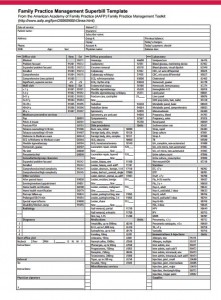You may have heard the term “SuperBill” tossed around at meetings but may not know exactly what one looks like or its importance to ICD-10 readiness. A SuperBill is simply an itemized form healthcare provider’s use to reflect services rendered in a patient visit. It is generally customized for a provider’s practice and contains patient information, as well as several diagnoses and procedures from which to choose, currently all in ICD-9 (see Exhibit 1). In short, SuperBills are the backbone of charge capture and integral to ensuring that ICD-9 CM, CPT-4, HCPCS codes and appropriate modifiers are billed.
Exhibit 1: Original ICD-9-CM SuperBill
(from the AAFP, https://www.aapc.com/icd-10/superbills.aspx)
At NYP, the initiative to convert all areas from paper SuperBills, also known as encounter forms, to electronic SuperBills capable of interfacing to our billing system began in 2010. This has been part of an ongoing effort towards a paperless revenue cycle. As NYP prepares for the implementation of ICD-10, it is critical that all clinical areas on paper encounter forms are transitioned onto the electronic SuperBill to facilitate conversion of the ICD-9 diagnosis codes to the equivalent ICD-10 options. This is because the increased complexity and granularity of ICD-10 coding will exponentially increase the volume of ICD-10 codes, no longer allowing paper to be a viable option charge and code capture. For example, a two-sided 8 ½ x 11 inch paper encounter form in ICD-9 might require a 15+ page form once converted to ICD-10. Multiple page encounter forms are not only impractical, but also costly and time consuming to complete. If your clinical staff is still using paper forms to capture important diagnosis, charge, and billing information, prepare your practice for the transition to ICD-10 and convert to electronic SuperBill. Contact project leaders, John Tallent (jot9032@nyp.org) and Jerilyn Loria (jel9085@nyp.org) for more details.
